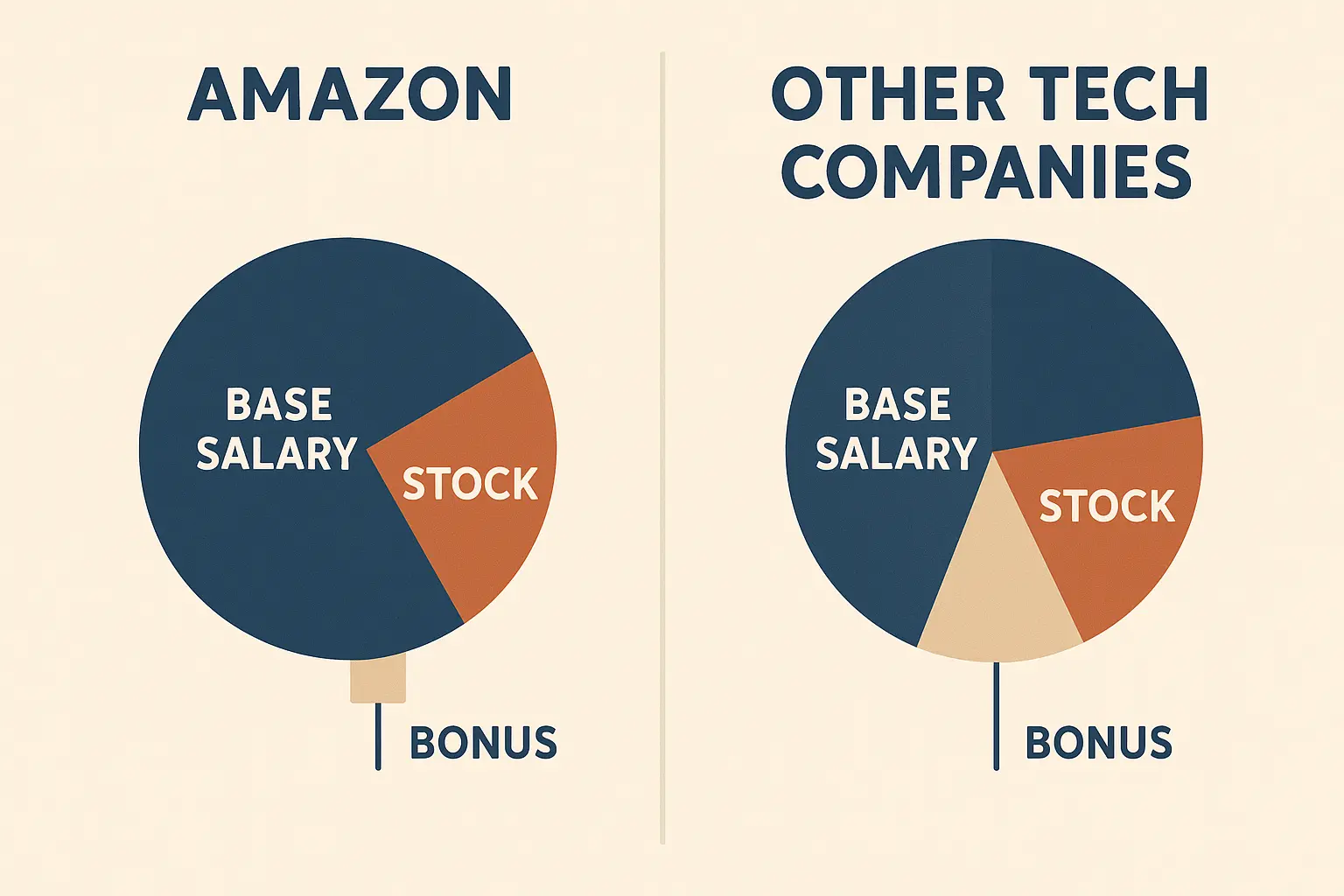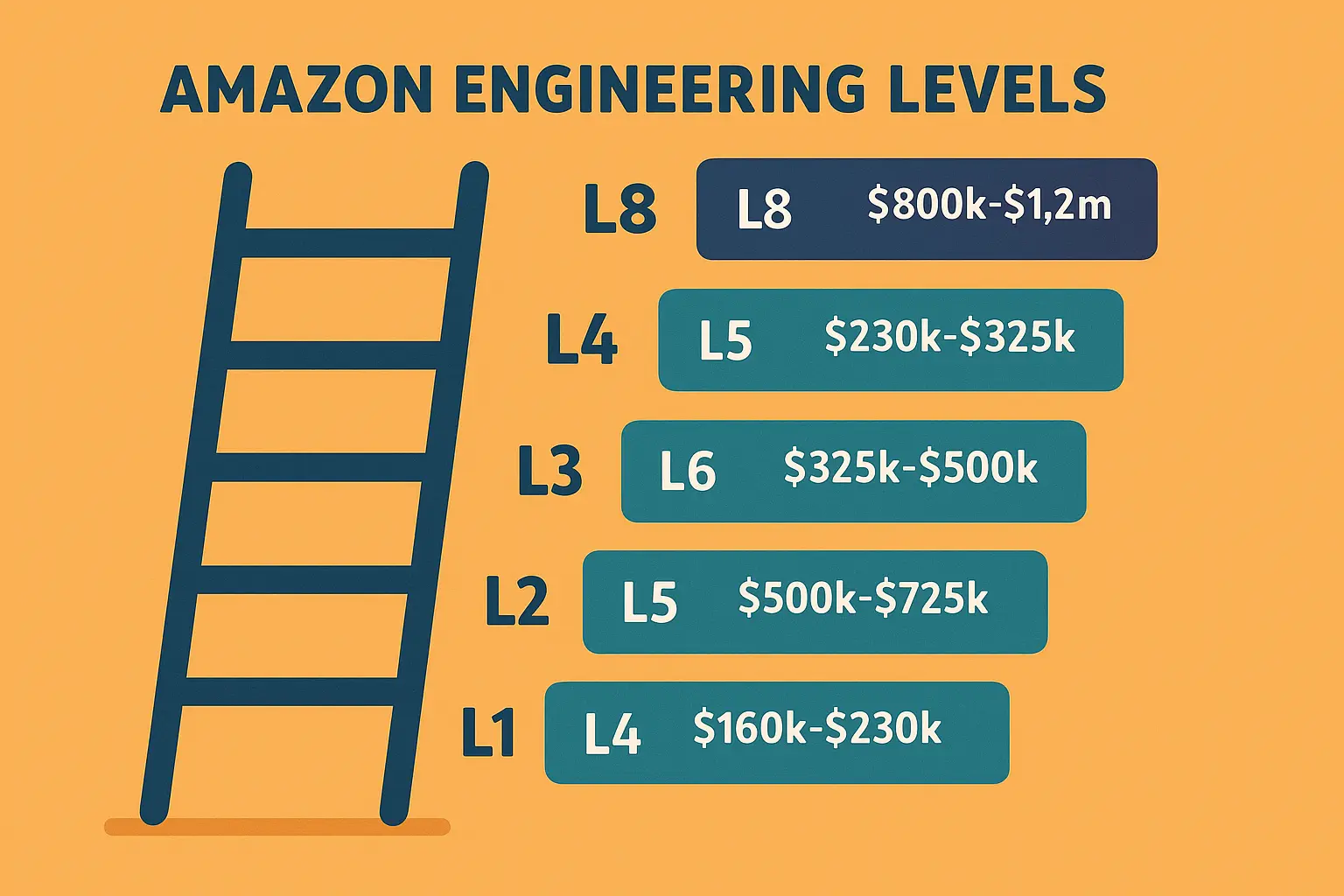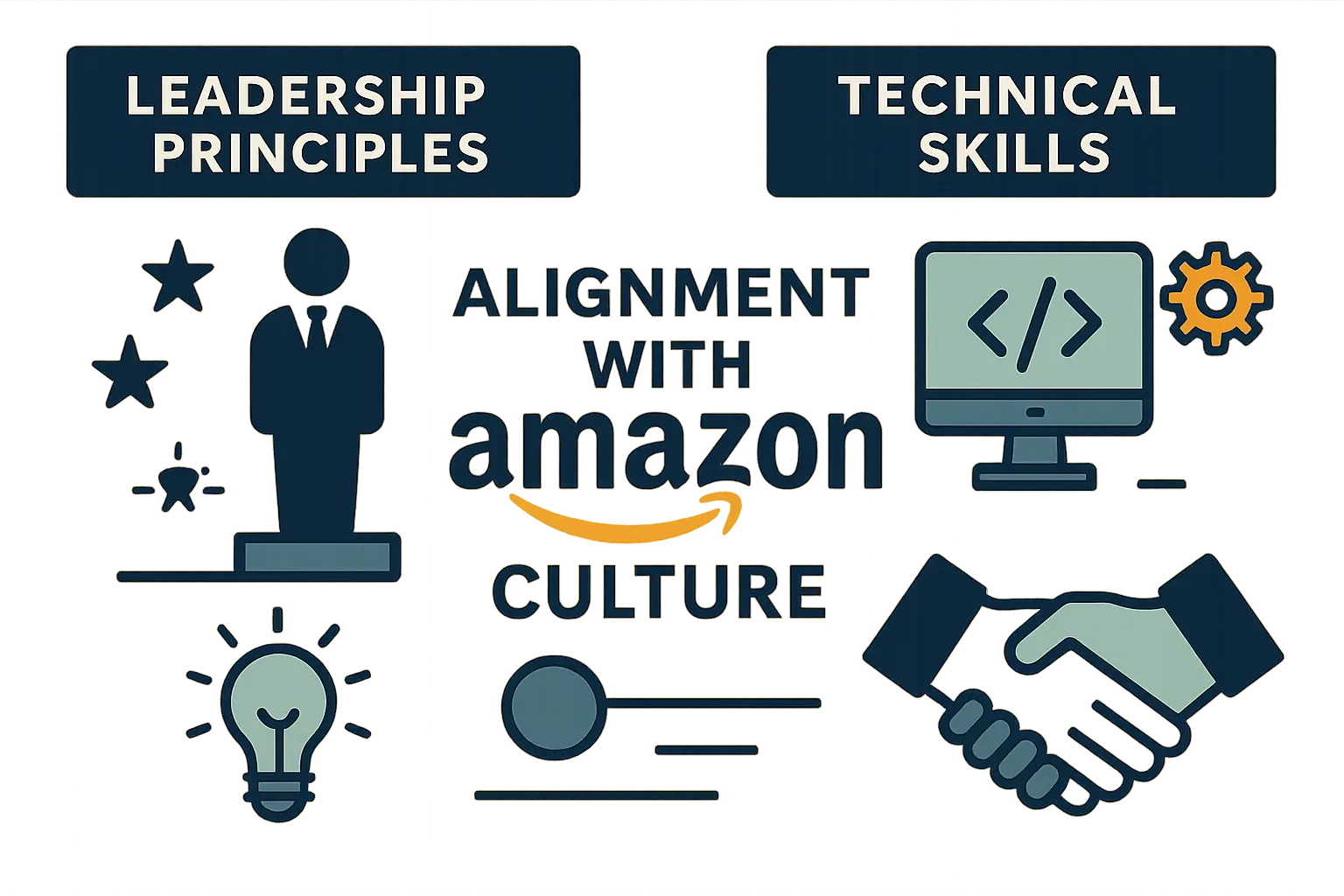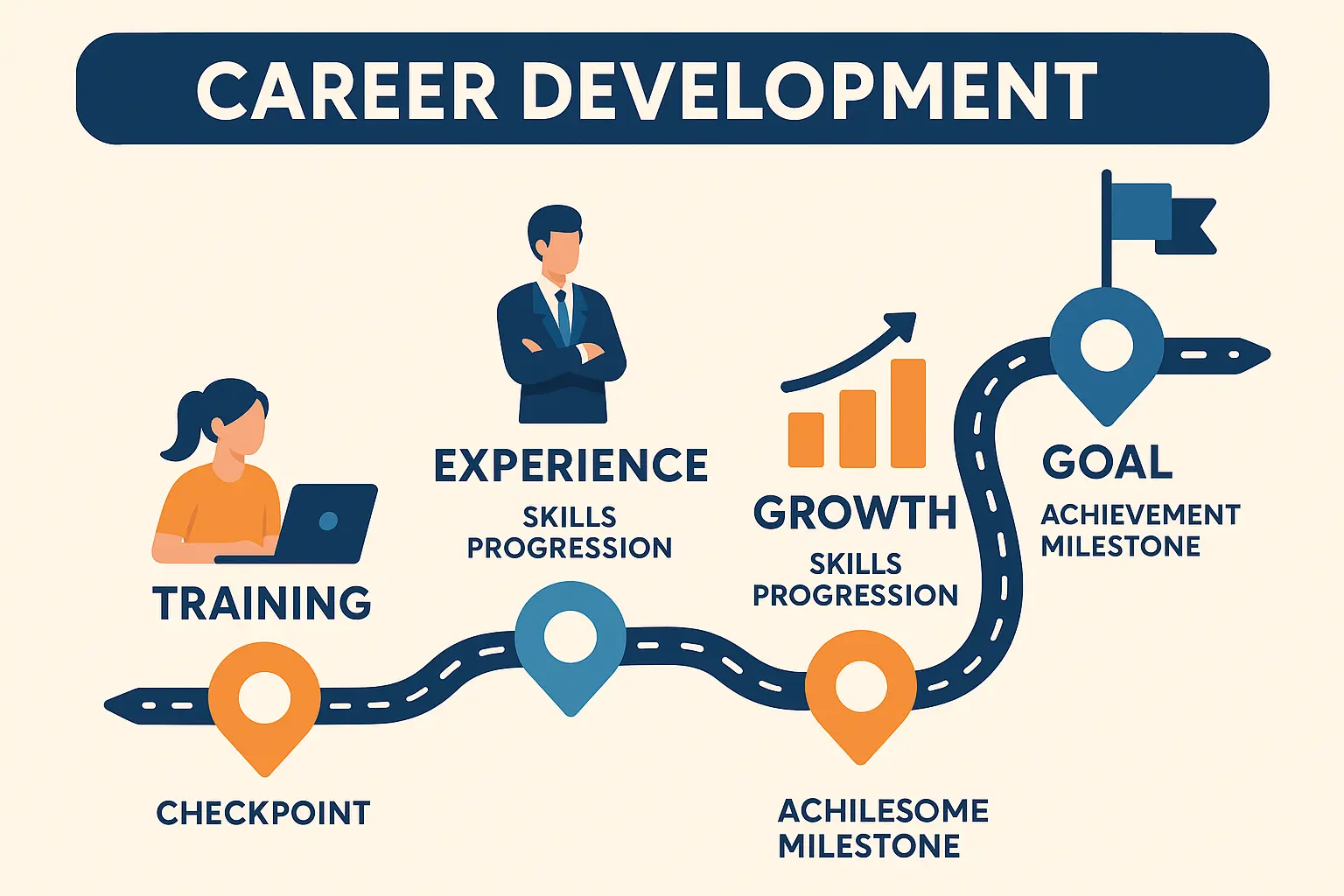Last month, I spent way too much time digging through Amazon salary data because honestly? Their pay structure is weird, and I wanted to understand it.
Here’s the thing everyone gets wrong about Amazon software engineer salary: it’s not just about the number. A $300k total package at Amazon feels completely different from $300k at Google, and I’ll show you why.
The short version: Amazon pays well, but they do it in their own special way that can either work really well for you or leave you scrambling to pay rent in year two. According to recent data from Levels.fyi, software engineer compensation at Amazon ranges from $181K per year for L4 to $1.66M per year for L10, with the median yearly compensation package totaling $252K. New grads start around $200k total comp, but watch out for that second-year cliff. Senior engineers can hit $400k+, but only if you understand the game they’re playing.
Table of Contents
-
Why Amazon’s Pay Structure Feels Backwards
-
Your First Amazon Paycheck (And Why Year Two Sucks)
-
Actually Getting More Money From Amazon
-
Planning Your Money Around Amazon’s Weird Structure
-
What You’ll Actually Make at Each Level
-
Positioning Yourself for Maximum Pay
-
Final Thoughts
TL;DR
-
Amazon’s compensation is heavily weighted toward equity, with RSUs making up 60-70% of total pay for senior engineers
-
First-year total compensation for new grads ranges from $180,000-$220,000, but drops significantly in year two due to back-loaded vesting
-
The company uses massive signing bonuses to offset low equity vesting in years one and two
-
Negotiation works best with competing offers from other FAANG companies, especially those offering better cash compensation
-
Geographic location dramatically impacts pay, with Seattle, SF, and NYC commanding 20-30% premiums
-
Career progression from L4 to L5 typically increases total compensation by 40-60% within 2-3 years
-
Principal engineers (L7+) can earn $400,000-$600,000+ annually with significant equity components
Why Amazon’s Pay Structure Feels Backwards
Most tech companies try to keep your paycheck relatively steady year over year. Amazon? They basically said “nah” to that entire concept.
Here’s what they do instead: They give you a fat signing bonus upfront, keep your equity super low in years one and two, then dump a ton of stock on you in years three and four. It’s like they’re betting you’ll stick around for the full four years, and honestly, it works.
Real example: My friend Sarah joined as a new grad with what looked like a $205k first-year package. Great, right? Year two dropped to $175k. She wasn’t prepared for that $30k hit and had to move back in with roommates.
The reason? Amazon front-loads your compensation with signing bonuses that disappear, while your equity follows this bizarre 5%-15%-40%-40% vesting schedule. Most companies do 25% each year. Amazon decided to be different.
Look, Amazon isn’t trying to be your friend with their compensation. They’re trying to solve a problem: how do you keep good engineers from jumping ship every two years?
Their solution is pretty clever, if you think about it. Instead of competing dollar-for-dollar with Google’s cash-heavy offers, they created this weird equity structure that basically says “stick around and we’ll make it worth your while.”
Recent federal filings revealed that “Amazon is paying software engineers in its Amazon Web Services cloud division as much as $185,000, while software developers working at Amazon.com make up to $263,700” according to Business Insider analysis. These figures represent base salaries only and don’t include the substantial equity components that make up the majority of total compensation.
The Four Parts of Your Amazon Paycheck
Base Salary: The Boring Part
This is your guaranteed money – usually capped around $185k no matter how senior you get. Amazon keeps this intentionally lower than competitors because they want the exciting stuff (equity) to be where you make real money.
Stock (RSUs): The Golden Handcuffs
Here’s where it gets interesting. That 5%-15%-40%-40% vesting schedule isn’t an accident – it’s designed to make leaving after year two financially painful. I know L6 engineers whose equity grants are worth more than their salary by year three.
Signing Bonus: The Hook
Amazon throws big signing bonuses at you (sometimes $150k+) to make up for the crappy equity vesting early on. But here’s the catch – leave within two years and you pay it back. It’s basically a loan against your future equity.
Performance Bonus: The Wild Card
This can be anywhere from zero to 30% of your base, depending on how well you do and how your team performs. Top performers consistently hit 20-25%, while average folks see maybe 10-15%.
Why Location Actually Matters More Than You Think
Amazon adjusts pay by location, but not always in ways that make sense. A Seattle engineer might make $350k total comp, while someone in Austin makes $290k doing the exact same job. The cost of living difference? Not nearly that big.
The sweet spots are often places like Austin or Denver where you get decent Amazon pay but reasonable living costs. San Francisco pays more, but good luck affording anything.
|
Location |
L6 Base Salary Range |
Total Comp Range |
Cost of Living Multiplier |
|---|---|---|---|
|
Seattle, WA |
$165,000-$185,000 |
$320,000-$380,000 |
1.0x (baseline) |
|
San Francisco, CA |
$170,000-$190,000 |
$350,000-$420,000 |
1.15x |
|
New York, NY |
$168,000-$188,000 |
$340,000-$400,000 |
1.12x |
|
Austin, TX |
$155,000-$175,000 |
$290,000-$350,000 |
0.85x |
|
Denver, CO |
$150,000-$170,000 |
$280,000-$340,000 |
0.82x |
Your First Amazon Paycheck (And Why Year Two Sucks)
New grads, listen up. Your first year at Amazon is going to feel great financially. Year two? Not so much.
Here’s what actually happens: You start with maybe $205k total comp (base + signing bonus + tiny bit of equity). You’re feeling pretty good about life. Then year two hits and suddenly you’re down to $175k because half your signing bonus is gone and your equity is still basically nothing.
This isn’t Amazon being sneaky – it’s intentional. They want you to feel that financial pressure in year two so you stick around for the big equity payoff in years three and four.
Pro tip: Budget based on your year-two compensation, not year one. Treat that extra first-year money as a bonus, not your new normal.
What New Graduates Actually Earn in Year One
Amazon’s entry-level packages create an interesting financial situation where your first year looks great, but year two requires careful budgeting. Total first-year compensation typically ranges from $180,000-$220,000, including base salary, signing bonus, and prorated equity.
The base salary component usually falls between $130,000-$165,000, representing your guaranteed cash income. This provides a solid foundation, though it’s often lower than what you might receive at Google or Meta for equivalent roles.
Getting From L4 to L5 (Your First Real Raise)
The jump from new grad (L4) to mid-level (L5) is huge – we’re talking 40-60% more total comp. But it’s not automatic, and it’s not just about time served.
Amazon wants to see you handling ambiguous problems, not just cranking out tickets. Can you figure out what needs to be built when the requirements are vague? Can you influence other teams to help with your project? That’s L5 thinking.
Most people make this jump in 2-3 years if they’re proactive about it. The ones who wait for someone to promote them? They wait a lot longer.
Successful L4 to L5 promotions require demonstrating technical growth, project ownership, and alignment with Amazon’s leadership principles. The compensation jump makes this promotion particularly valuable for long-term earning potential.
For engineers considering their educational foundations, understanding software engineer education requirements can help position yourself for faster career advancement and higher compensation tiers.
New Grad Promotion Readiness Checklist:
-
Consistently delivered projects on time with minimal guidance
-
Identified and solved problems beyond assigned scope
-
Mentored newer team members or interns
-
Led technical design for medium-complexity features
-
Received “Exceeds Expectations” or higher on performance reviews
-
Demonstrated ownership of code quality and system reliability
Actually Getting More Money From Amazon
Negotiating with Amazon is weird because they have these rigid pay bands, but there’s more flexibility than most people realize.
When They’ll Actually Negotiate
Amazon negotiates when they have to, not when they want to. The best leverage is a competing offer from Google, Meta, or Microsoft – companies they actually compete with for talent. Your startup offer with uncertain equity? They don’t care.
The magic happens when you can show them they’re about to lose you to a competitor. Suddenly those “rigid” pay bands become surprisingly flexible.
Amazon’s compensation teams operate within established bands and approval processes, but they do have flexibility for the right candidates. The best negotiation opportunities occur during initial offer discussions and annual review cycles. Mid-year requests rarely succeed unless you have a competing offer or promotion justification.
What Actually Works in Negotiations
Competing offers: Get real offers from real companies. Amazon’s compensation team can smell a fake offer from a mile away.
Timing: End of quarter, end of year, or when they desperately need to fill a role. Budget cycles matter more than you think.
Focus on total comp: Don’t get hung up on base salary – Amazon has hard caps there. But they can be creative with equity and bonuses.
Be professional: Ultimatums backfire. Present your case, give them time to respond, and be willing to walk away.
Credible competing offers from tier-1 tech companies carry the most weight in Amazon negotiations. Offers from Google, Meta, Microsoft, or Apple create immediate urgency and often unlock higher compensation bands.
Mike’s Negotiation Success: Mike received an Amazon L5 offer of $165k base + $150k RSUs + $60k signing bonus. He also had a Google offer of $175k base + $180k RSUs + $40k signing bonus. By presenting the Google offer professionally and emphasizing his interest in Amazon’s mission, he negotiated his Amazon base to $172k and RSUs to $170k, resulting in $15k additional annual value.
The Stuff Nobody Talks About
Sometimes the best “negotiation” isn’t about money. Extra vacation days, flexible work arrangements, or getting your review cycle moved up can be worth thousands of dollars in practical value.
When salary caps are reached, negotiating for additional vacation time, flexible work arrangements, or accelerated review cycles can add significant value to your overall package.
Planning Your Money Around Amazon’s Weird Structure
Amazon’s pay structure creates some unique financial planning challenges. Years three and four can push you into higher tax brackets when all that equity vests. Plan for it.
The Tax Bomb Nobody Warns You About
When your RSUs vest, they’re taxed as regular income at today’s stock price. If Amazon’s stock has done well, you could owe way more in taxes than you expected. I know engineers who got hit with $50k+ tax bills they weren’t ready for.
Simple fix: Set aside money from each vesting event to cover taxes. Don’t spend it all and assume you’ll figure out taxes later.
Amazon’s RSU structure creates tax events that many engineers don’t anticipate. When your shares vest, they’re taxed as ordinary income at their current market value, potentially pushing you into higher tax brackets during heavy vesting years.
Years three and four of your initial grant can create significant tax obligations as 40% of your equity vests each year. Planning for these tax events through estimated payments or tax-advantaged account contributions becomes crucial.
The Stay vs. Leave Decision
Around year two or three, you’ll face the big question: stay for the equity or leave for something new? There’s no right answer, but there’s math you can do.
Calculate what you’re leaving on the table (unvested equity) versus what you could make elsewhere. Sometimes staying makes financial sense even if you’re not loving the job. Sometimes leaving is worth the financial hit for better opportunities.
Amazon’s back-loaded vesting creates a complex decision point around year two or three of employment. Leaving before full vesting means forfeiting substantial equity, but staying might limit other career opportunities.
Building Long-Term Wealth Beyond Your Amazon Salary
Amazon compensation provides an excellent foundation for wealth building, but diversification becomes important as your equity concentration grows. Many engineers reinvest vested shares into broader market index funds or real estate.
The key is avoiding lifestyle inflation that matches your peak vesting years, since future grants might not maintain the same value if Amazon ‘s stock performance changes.
Jessica’s Wealth Building Strategy: As an L6 engineer with $400k total compensation, Jessica automatically invests 50% of her vested RSUs into a diversified index fund portfolio. She maintains her lifestyle based on her base salary ($170k) plus signing bonus, treating equity as long-term wealth building. After four years, this strategy built a $300k investment portfolio separate from her Amazon equity concentration.
What You’ll Actually Make at Each Level
Here’s the real talk on Amazon levels and what they pay:
L4 (New Grad): $180k-$220k total comp. You’re learning the ropes.
L5 (Mid-Level): $240k-$320k total comp. This is where most engineers settle in comfortably.
L6 (Senior): $320k-$450k total comp. You’re leading projects and mentoring people.
L7+ (Principal): $450k+ total comp. You’re setting technical direction for multiple teams.
The jump from L5 to L6 is huge – both in responsibility and pay. But it’s also where things get political. Technical skills alone won’t cut it anymore.
Mid-Level Engineer Compensation Reality
The jump from entry-level to mid-level engineering roles at Amazon represents a significant compensation increase and responsibility shift. These roles form the backbone of Amazon’s engineering organization.
SDE II (L5): Where Most Engineers Land
L5 engineers typically earn $180,000-$250,000 in total compensation, with base salaries ranging from $155,000-$185,000 depending on location and performance. This level represents the sweet spot for many engineers who want technical challenges without management responsibilities.
The L5 compensation structure becomes more equity-heavy than L4 roles, with RSU grants often exceeding base salary value over the four-year vesting period. Performance bonuses at this level consistently range from 15-25% for solid performers.
Senior SDE (L6): The Technical Leadership Tier
L6 roles command $280,000-$400,000 total compensation, marking the transition into senior technical leadership. Engineers at this level often lead complex projects and mentor junior team members.
The equity component becomes substantial at L6, with many engineers receiving RSU grants worth $200,000-$300,000 over four years. This level also unlocks additional retention bonuses during critical projects or competitive hiring periods.
Principal and Distinguished Engineer Packages
L7+ positions represent Amazon’s technical leadership tier, with compensation packages designed to retain top talent and compete with startup equity opportunities.
Staff Engineer (L7): Breaking Into the Big Leagues
Principal engineers earn $400,000-$600,000 annually, with significant equity components and potential for additional retention bonuses. These roles require deep technical expertise and the ability to influence engineering decisions across multiple teams.
The compensation at L7 often includes custom retention packages, especially for engineers with specialized skills in high-demand areas like machine learning, distributed systems, or security.
According to
Distinguished Engineer: The Technical Elite
L8+ roles can exceed $800,000 in total compensation, often including custom retention packages and direct reporting relationships to senior leadership. These positions are rare and typically reserved for engineers with industry-wide recognition.
Distinguished engineers often receive equity grants that vest over longer periods, sometimes five or six years, with additional performance-based bonuses tied to major technical initiatives.
|
Level |
Title |
Base Salary |
Total Comp Range |
Typical Experience |
|---|---|---|---|---|
|
L4 |
SDE I |
$130K-$165K |
$180K-$220K |
0-2 years |
|
L5 |
SDE II |
$155K-$185K |
$240K-$320K |
2-5 years |
|
L6 |
SDE III |
$165K-$190K |
$320K-$450K |
5-8 years |
|
L7 |
Principal SDE |
$185K-$210K |
$450K-$650K |
8-12 years |
|
L8 |
Senior Principal |
$200K-$230K |
$650K-$900K |
12+ years |
Getting Real Salary Data
Levels.fyi is your friend, but take everything with a grain of salt. Join Blind for the unfiltered takes from current employees. Schedule coffee chats with people at your target level – most engineers are happy to share general ranges.
The key is getting recent data. Amazon software engineer salary changes frequently based on market conditions and stock performance.
Getting accurate salary information requires going beyond basic salary websites. Create accounts on Levels.fyi and Blind for the most current Amazon compensation data. These platforms aggregate real offer data and provide location-specific insights that generic salary sites miss.
Join Amazon-specific professional networks and LinkedIn groups where current employees share recent compensation changes and promotion experiences. Internal forums often reveal information about team-specific bonuses or retention packages.
According to Dice’s analysis, “base salary is generally capped under $165K for most mid-level roles due to Amazon’s internal pay band policy.”
Positioning Yourself for Maximum Pay
Beyond negotiation tactics, there are strategic things you can do to maximize your Amazon compensation over time.
Build the Right Technical Skills
Amazon loves engineers who can think at scale. Distributed systems, performance optimization, system design – these skills directly translate to higher levels and better pay.
Don’t just code features. Understand the systems they run on, the trade-offs involved, and how to make them better. That’s the thinking that gets you promoted.
Amazon heavily weights system design experience and architectural thinking in their leveling decisions. Engineers who can demonstrate experience with large-scale distributed systems, microservices architecture, and performance optimization at scale position themselves for higher compensation bands.
Your portfolio should showcase projects that handle significant user load, complex data processing, or cross-team integration challenges. Amazon’s interviewers and promotion committees look for evidence that you can think beyond individual features to system-wide impact.
Document Your Impact
Amazon’s promotion process loves quantifiable results. “I improved system performance” is okay. “I reduced latency by 40% and saved $2M annually in server costs” gets you promoted.
Keep a running doc of your wins. When review time comes, you’ll be ready.
Amazon’s promotion and compensation decisions increasingly focus on measurable business impact rather than just technical achievements. Engineers who can articulate their contributions in terms of cost savings, user experience improvements, or revenue impact receive higher ratings and faster advancement.
Track metrics like system performance improvements, operational cost reductions, or user engagement increases that resulted from your technical work. These quantifiable results provide concrete justification for compensation increases during review cycles.
Play the Internal Transfer Game
Sometimes the fastest way to more money is switching teams internally. High-priority teams often have more budget flexibility and faster promotion tracks.
Keep your ear to the ground for teams that are hiring aggressively or working on CEO-level priorities. Those teams can often offer accelerated advancement.
Teams working on customer-facing features, cost optimization, or revenue-generating services often have more budget flexibility for top performers. Research recent team accomplishments, leadership priorities, and technical challenges before salary discussions.
Demonstrating Leadership in Ambiguous Situations
Amazon’s leadership principles directly influence compensation discussions, particularly around promotion timing and performance ratings. Engineers who can show they’ve navigated unclear requirements, influenced technical decisions across teams, or driven projects without clear ownership structures stand out.
Document specific examples where you’ve identified problems that weren’t assigned to you, proposed solutions that required cross-team coordination, or delivered results when the path forward wasn’t obvious. These scenarios align perfectly with Amazon’s cultural expectations.
Strategic Timing of External Interviews
Obtaining competing offers requires careful timing to maximize their negotiation impact. The most effective approach involves scheduling other company interviews to conclude just before Amazon’s final rounds or annual review discussions.
This timing gives you maximum leverage while demonstrating that you’re a sought-after candidate in the broader market. Amazon’s compensation teams respond most favorably to competing offers that create genuine decision pressure rather than hypothetical alternatives.
Many Amazon engineers find that showcasing their educational credentials through professional diploma replacements helps during internal transfers and external opportunities, ensuring their qualifications are properly documented for career mobility.
For engineers pursuing advanced positions, understanding the value of formal education credentials can provide additional leverage in compensation discussions and career advancement opportunities.
Career Positioning Action Plan:
Technical Portfolio Development
-
Build projects demonstrating large-scale system design
-
Contribute to open-source projects relevant to Amazon’s tech stack
-
Document architectural decisions and trade-offs in your work
-
Obtain AWS certifications relevant to your target role
Leadership Experience Documentation
-
Lead cross-functional projects or initiatives
-
Mentor junior engineers or interns
-
Present technical solutions to stakeholders
-
Drive process improvements within your team
Business Impact Measurement
-
Track performance metrics for systems you’ve worked on
-
Calculate cost savings from optimizations you’ve implemented
-
Measure user engagement improvements from your features
-
Document operational efficiency gains from your solutions
Professional documentation of educational credentials becomes crucial when navigating Amazon’s competitive hiring process and internal career progression. Many software engineers find themselves needing backup copies of their degrees for multiple office locations, international opportunities within Amazon’s global organization, or networking events where showcasing qualifications enhances professional credibility.
Engineers who have experienced credential challenges often benefit from understanding how to obtain diplomas from closed institutions, ensuring their educational background is properly documented for career advancement.
For professionals seeking to enhance their credential presentation, exploring professional diploma display options can help create impressive office presentations that reinforce your qualifications during team meetings and client interactions.
Final Thoughts
Amazon’s compensation is complicated, but it’s not random. They’ve designed a system that rewards loyalty and performance, while keeping costs manageable for them.
If you can navigate the weird vesting schedule, negotiate effectively, and position yourself for advancement, Amazon can be incredibly lucrative. But it requires patience and strategic thinking.
The engineers who do best at Amazon treat their compensation as a long-term wealth-building strategy, not just a paycheck. If you can think that way, Amazon’s weird system starts to make a lot more sense.
Amazon software engineer salary structures reward patience and performance, but they require careful financial planning and strategic career thinking. The back-loaded equity vesting creates real wealth for engineers who stay, while the performance-driven culture provides clear paths for advancement.
Understanding the full compensation picture—from RSU taxation to negotiation timing—gives you significant advantages in maximizing your earning potential. The key is viewing your Amazon compensation as part of a broader career strategy rather than just a paycheck.
Whether you’re considering your first Amazon role or planning your next career move, the compensation data and strategies outlined here provide a foundation for making informed decisions. The tech industry moves quickly, but the fundamentals of Amazon’s compensation philosophy remain consistent enough to guide your planning.
And remember – compensation is just one part of your career equation. Make sure the work, team, and growth opportunities align with your goals too. All the money in the world isn’t worth being miserable for four years.










